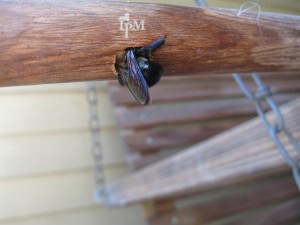Carpenter bees are common spring and summer insects in the eastern United States. They first come to attention when males “buzz” or “dive bomb” people passing by and females are seen excavating holes in wooden structures. Like carpenter ants, carpenter bees do not eat wood, but rather use the substrate for nesting. They are important pollinators, but can become a nuisance pest of structures.

Carpenter bee females create galleries or tunnels in dry wood during the spring. Bees bore into the wood, then turn 90 degrees to tunnel along the grain.
Did You Know…?
- By the numbers: Carpenter bees are solitary insects that do not form colonies, but many females may nest in the same area.
- Mock attack: If males feel their nests are threatened, they will aggressively pursue and harass, but they have no stinger.
- Look-alikes: Both carpenter and bumble bees are black and yellow, but bumble bees have fuzzy abdomens while carpenter bees are smooth.
- Galleries: On average, galleries are 4 – 6”, but tunnels can extend up to 10 feet long.
- Collateral Damage: In addition to the structural damage caused by carpenter bee tunneling, empty galleries can invite secondary pests such as beetles, moths and scavengers, and even fungal rot when moisture enters openings.
Integrated pest management can help to prevent carpenter bees from redecorating your home. See Get Rid of Carpenter Bees? Yes, Please! fact sheet for more information on carpenter bees and how to manage them.